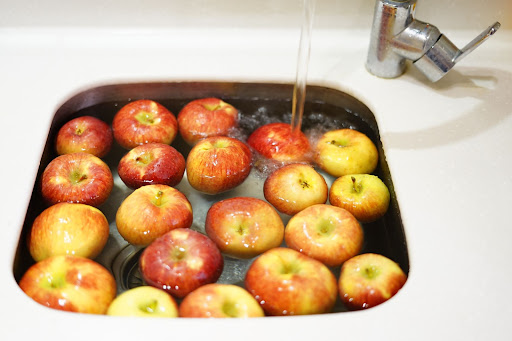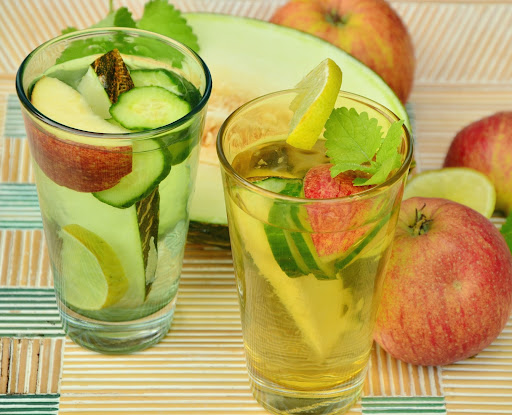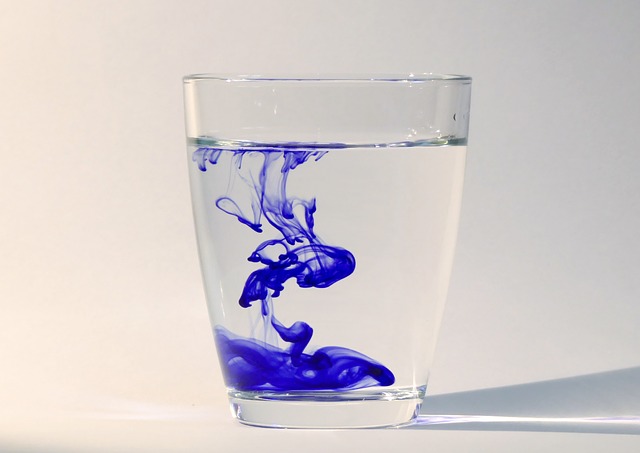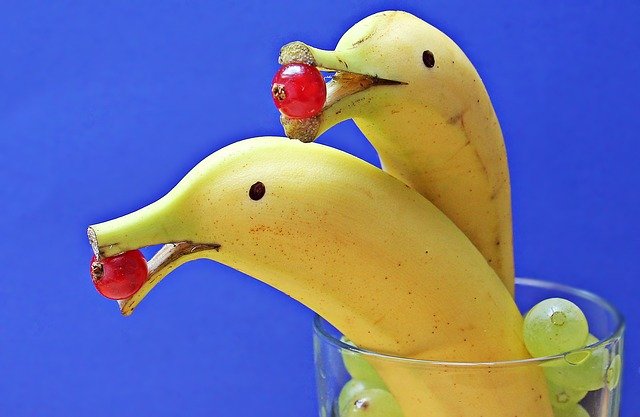Food Science – Floating and Sinking (Density & Buoyancy)
 Molecules are groups of atoms that are bonded together. Density relates to how tightly or loosely packed an object’s molecules are. Materials with more density weigh more. For example, jelly beans have more mass than marshmallows because marshmallows contain a great deal of air. So a cup of jelly beans weighs more than a cup of marshmallows.
Molecules are groups of atoms that are bonded together. Density relates to how tightly or loosely packed an object’s molecules are. Materials with more density weigh more. For example, jelly beans have more mass than marshmallows because marshmallows contain a great deal of air. So a cup of jelly beans weighs more than a cup of marshmallows.
For an object to float, it must have less density than the liquid it is floating in. Plain water from your faucet has a density of 1 g/mL (one gram per milliliter). So things that float in water (like ice cubes) have less density than 1 g/mL.
Experiments related to Density & Buoyancy
Fill a large bowl about three quarters full of water.
Push an apple to the bottom of the bowl of water and then release it. Does the apple stay at the bottom of the bowl or does it float? Therefore, does the apple have less density than water or more density than water?
Another Experiment:
Oil floats atop water because oil is less dense than water. Gather tap water, blue food coloring, an ice cube tray, and a clear plastic cup filled with cooking oil.
Add blue food coloring to water and pour the colored water into an ice cube tray, allowing it to freeze.
Fill the clear plastic cup about three-quarters full of oil. Remove a frozen blue ice cube from the tray and place it in the oil, letting it melt.
Is the ice cube floating in the oil or sinking to the bottom of the cup? Therefore is ice more or less dense than oil?
As the ice melts, watch what happens to the blue water that results from the melting. Is water more or less dense than oil? Is water more or less dense than ice? Explain how you know.
Link to a buoyancy experiment from The Indianapolis Public Library:
https://www.indypl.org/blog/for-kids/science-experiment-density-buoyancy
Quick Fact: Why Do Fruits Taste Sweeter As They Ripen?
Physical properties of fruits include how they look (size, color), how they feel (hard, squishy, slimy), and how they taste. A physical property of sugar molecules is their sweet taste. Starch is a nutrient, and starch molecules are made up of smaller sugar molecules that are bonded together in a chain. Starch doesn’t taste very sweet. This is why an unripe banana is not very sweet. But as a banana ripens, the starch molecules break apart into sugar molecules and banana tastes sweeter.
 Acids & Bases
Acids & Bases
Acids are chemicals with many hydrogen ions. Gastric acid fills our stomach to help break down food. Our stomachs have a special lining that keeps the acid from breaking down our tissue. Foods with a lot of acid often taste sour. Highly acidic foods include lemon juice, orange juice, and coffee. Bases are the opposite of acids. They have many hydroxide ions. A pH scale measures how acidic or basic a liquid is. Acids have very low numbers on the pH scale and bases have higher numbers.
An introduction to acid and bases: https://www.sciencelearn.org.nz/resources/3019-acids-and-bases-introduction
Chemistry for Kids (including a pH scale): https://www.ducksters.com/science/acids_and_bases.php
An Experiment with Acids and Bases
- Gather some sour (acidic) candies such as sour Skittles, Sour Patch Kids, Pixy Stix, Warheads, or Lemonheads.
- Drop some of the candy into a ½ cup of warm water and let the candy dissolve. (Stirring will help!)
- Then drop a spoonful of baking soda (a base) into the water.
- You will see bubbles form. This happens because when a base mixes with an acid, carbon dioxide is released. The more acidic the candy, the more bubbles that you’ll see.
(This same chemical reaction occurs in baked goods like crackers, cookies, and pancakes. The baking soda in the recipe reacts with acid in the dough which releases carbon dioxide and causes the dough to rise!) - Extra: You can also use baking soda to perform an acid test on a variety of liquids. Add two tablespoons of orange juice to a small cup, add two tablespoons of apple cider to another small cup, and add two tablespoons of milk to a third cup. Remember that when a base like baking soda interacts with an acid, carbon dioxide is released which causes bubbles. Now add ½ teaspoon of baking soda to the cup with the milk. How many bubbles are formed? Is milk acidic or basic? Add ½ teaspoon of baking soda to the cup with the apple cider? What is your conclusion about how acidic cider is? Now add ½ teaspoon of baking soda to the cup with the orange juice. What do you notice? Which is the most acidic liquid of the three? Which is the least acidic?
Quick Fact: Why Does Corn Pop?
From the U.S. Department of Agriculture https://www.nal.usda.gov/exhibits/speccoll/exhibits/show/popcorn/how-does-popcorn-pop-
“A kernel of popcorn does contain a small amount of water stored inside a circle of soft starch. This is why popcorn needs to maintain a certain level of moisture. The soft starch is surrounded by the kernel’s hard outer surface. As the kernel heats up, the water expands, building pressure against the hard starch surface. Eventually, this outer layer gives way, causing the popcorn to explode. As it explodes, the soft starch inside the popcorn becomes inflated and bursts, turning the kernel inside out. The steam inside the kernel is released, and the popcorn is popped, hot and ready to eat.”
 Solutes & Solvents
Solutes & Solvents
Ducksters Chemistry for Kids – Solutions and Dissolving
https://www.ducksters.com/science/chemistry/solutions_and_dissolving.php
In a solution, one substance is dissolved within another substance. A solution is homogeneous (the same throughout) and the substances remain mixed – they do not separate from one another over time. A food example of a solution is Kool-Aid. Temperature is one factor that affects the rate at which a solute goes into a solvent.
An Experiment for Solutions and Dissolving Rates Based on Temperature
You will need:
- ½ cup ice water
- ½ cup room-temperature water
- ½ cup boiling water (make sure to get an adult’s help)
- 1 package unsweetened Kool-Aid
- Sugar
- 3 clear glass tumblers (one must be able to withstand hot water)
- Put ½ cup of ice water in the first glass, ½ cup of room-temperature water in the second glass, and ½ cup of boiling water in the third glass.
- Drop a small pinch of Kool-Aid into each glass. Watch the Kool-Aid diffuse into solution in each.
In which glass does the Kool-Aid dissolve most quickly? In which glass does it take the most time? What does this tell you about how temperature affects how quickly a substance can dissolve and create a solution?
See These Websites For More Cool Experiments with Food!
Food Science Experiments for Kids: https://a2zhomeschooling.com/explore/chemistry_kids/food_chemistry_experiments/
100 Amazing Food Experiments for Kids: https://www.123homeschool4me.com/100-amazing-food-experiments-for-kids/
Edible Science Experiments for Kids:
https://www.mombrite.com/edible-science-experiments-for-kids/
Steve Spangler Food Science Experiments:
https://www.stevespanglerscience.com/lab/categories/experiments/food-science/
Food Science for Kids:
https://www.sciencekids.co.nz/food.html
 Play & Learn
Play & Learn
Crafts
Fun Ways to Use Food in Kids Crafts: https://www.diys.com/use-food-in-kids-crafts/
Games
Kids Food Games: https://www.culinaryschools.org/kids-games/
Food Games ABCya: https://www.abcya.com/games/category/food
Quizzes
Food Quiz: https://www.sciencekids.co.nz/quizzes/food.html
Fun Activities (coloring pages, word searches, etc.)
Coloring pages:
http://www.supercoloring.com/coloring-pages/home-housework/food
https://coloringhome.com/free-printable-coloring-pages-food
Dot to Dot:
https://www.dottodots.net/category/food
https://www.foodhero.org/connect-dots
Food & Science Word Search:
https://drive.google.com/file/d/1VDGPXKbKMvHZtUPlT1El1GeTe5bbIODy/view?usp=sharing
Food Jokes and Puns: https://docs.google.com/document/d/1yjRcEhLEnqJSNbbRRhPIlI2ZjXxkqkheSfk-mJveEl4/edit?usp=sharing
Resources
Cobb, Vicki. Science Experiments You Can Eat. Harper Collins Publishers, 1994.
Leavitt, Loralee. Candy Experiments. Andrews McMeel Publishing, 2012.
VanCleave, Janice. 204 Sticky, Gloppy, Wacky & Wonderful Experiments. John Wiley & Sons, Inc., 2002.
